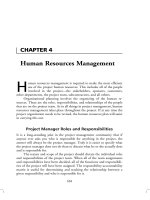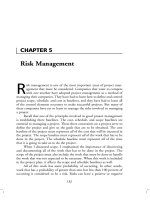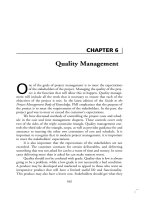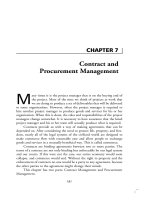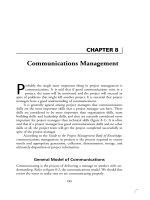Tài liệu Project Management Professional-Chapter 4 pptx
Bạn đang xem bản rút gọn của tài liệu. Xem và tải ngay bản đầy đủ của tài liệu tại đây (170.87 KB, 28 trang )
CHAPTER 4
Human Resources Management
H
uman resources management is required to make the most efficient
use of the project human resources. This includes all of the people
involved in the project—the stakeholders, sponsors, customers,
other departments, the project team, subcontractors, and all others.
Organizational planning involves the organizing of the human re-
sources. These are the roles, responsibilities, and relationships of the people
that are on the project team. As in all things in project management, human
resources management takes place throughout the project. If at any time the
project organization needs to be revised, the human resources plan will assist
in carrying this out.
Project Manager Roles and Responsibilities
It is a long-standing joke in the project management community that if
anyone ever asks you who is responsible for anything in the project, the
answer will always be the project manager. Truly it is easier to specify what
the project manager does not do than to discuss what he or she actually does
and is responsible for.
The nature and scope of the project should dictate the individual roles
and responsibilities of the project team. When all of the team assignments
and responsibilities have been decided, all of the functions and responsibili-
ties of the project will have been assigned. The responsibility-accountability
matrix is useful for determining and tracking the relationship between a
given responsibility and who is responsible for it.
104
105Human Resources Management
As can be seen in figure 4-1, the responsibility-accountability matrix is
a short notational form that allows us to easily see the relationship between
the individuals on a project team and the responsibilities they have. Various
levels of the responsibility-accountability matrix may be developed for vari-
ous parts and levels of the project.
The project manager, in order to determine when activities are sup-
posed to take place in the project, uses the project schedule (figure 4-2). It
constitutes the schedule for the work that has to be done. Of course, people
are involved with the work that has to be done. The project manager in a
matrix organization draws the people from the functional organization.
The functional manager must have a staffing plan that allows him or
her to know where the people in their functional organization are commit-
ted. If these commitments are not organized the utilization of the human
resources will be poor. A staffing plan for the functional manager is similar
to the project schedule, except that instead of showing the schedule for each
task in the project, it shows the schedule for each resource in the functional
manager’s responsibility.
Figure 4-1. Responsibility-accountability matrix.
Joe Mary Frank Louie
Requirements definition
Functional design
Detail design
Development
Testing
Key:
P—Participates
A—Accountable
R—Reviews
I—Input required
S—Sign off
S
S
S
R
RS
S
R
A
AP
P
A
A
P
.......................... 9618$$ $CH4 09-06-02 14:59:08 PS
106 Preparing for the Project Management Professional Certification Exam
Figure 4-2. Project schedule.
Task 1
Task 2
Task 3
Richard Cordes
Jeanette Williams
Nancy Brown
Figure 4-3. Staffing plan.
Richard Cordes
Nancy Brown
Project 1 Project 3 Project 4
Project 3Project 1Project 3
Strong Matrix, Weak Matrix, and Balanced Matrix
Strong Matrix
In a strong matrix organization the project manager has greater authority or
power than the functional manager. In this situation, project managers gen-
erally get the people they want. In fact the project managers in this type of
organization get more than they should. A manager that is assertive will
usually get the personnel he or she wants. The functional manager is not
able to overcome the project manager’s authority and is not free to assign
people where their talent is best utilized.
If this type of organization becomes stronger, most if not all of the
personnel will be working on projects, and project managers will be able to
draw more highly qualified people than are really needed for their projects.
The surplus personnel are traded between the project managers themselves,
bypassing the functional managers altogether. In this type of organization
the project manager has strong authority.
Weak Matrix
In the weak matrix organization, the project manager does not have as much
power as the functional manager. This usually occurs in organizations that
are moving into matrix management for the first time. The situation occurs
something like this: The chief executive officer, or CEO, of the company
.......................... 9618$$ $CH4 09-06-02 14:59:10 PS
Figure 4-4. Functional, weak, balanced, and strong matrix and pure project organizations
compared.
Characteristic
of
Organization
Functional
Project
manager
power
Percent
working full
time on project
Titles
Weak Matrix Balanced Matrix Strong Matrix Pure Project
None
Little and
limited
Even with
functional
manager
High Complete
0%
0% to 25% 15% to 60% 50% to 100% 100%
Project coordinator
Project lead
Project coordinator
Project lead
Project expeditor
Project manager Project manager
Program manager
Program manager
Project manager
..........................9618$$$CH409-06-0214:59:11PS
107
Human Resources Management
108 Preparing for the Project Management Professional Certification Exam
decides that matrix management is the thing for the company to do. Almost
overnight an attempt is made to change the organization from a functional
organization to a matrix management.
When this attempt is made, there is a reaction from the functional
managers. After all, these are the major human assets in the company. They
would not be in a position of authority if they were not good managers.
The functional managers see the problem in the new organization. In
the past, they had responsibility for the administration as well as the direct-
ing of work in their part of the organization. Under matrix management
they no longer direct some of the work that their people are doing. The
project manager will direct that work. This is a threat to the functional
managers. The salary that the company is going to pay the project managers
is going to come from someplace. Most likely it is going to come from cuts
in functional managers’ salary. The functional managers react by convincing
the upper management of the company to only allow the project managers
to recommend work to be done, and the functional managers will continue
to actually direct the work.
This form of matrix management can be used if there is a transition
going on. In the beginning of the transition to matrix management, the
project managers are new and inexperienced. As the project managers gain
experience, they should be given more authority over the people who report
to them. At the same time, the functional managers can be transitioned out
of the organization and promoted into higher and more responsible jobs. As
the functional managers move on, more appropriate administrative managers
can replace them, and direction of the work can be managed by the project
manager.
Balanced Matrix
In the balanced matrix organization, the power levels of the functional man-
ager and the project manager are in balance. By that I mean that the func-
tional manager cannot force the project manager, and the project manager
cannot force the functional manager. The functional manager makes the
decisions about where the people in his or her department will be assigned,
and the project manager works with the functional manager to recruit the
proper person for the project assignment.
A balancing rule can be applied. By setting a specific interval of time as
a requirement for moving a person to the project team, balance can be
achieved. For example, a person who is required to work full time on a
project for two months is transferred to the project, while a person who
.......................... 9618$$ $CH4 09-06-02 14:59:12 PS
109Human Resources Management
would be required to work less than two months remains in his or her
functional department. The person working greater than two months would
be physically moved to the project space and would return to the functional
area when the work is completed. The person working less than two months
on the project remains under the supervision of the functional manager. The
project manager authorizes the work to be done in the functional area by
generating a work order or some other device.
By adjusting the balance point, more or less work can be made to
happen in the functional areas. If more work is being handled in the project,
the project manager has more people reporting to him or her, increasing the
project manager’s power level. At one extreme we have a strong matrix,
where the length of time required to move a person to the project team is
very short. At the other extreme we have a weak matrix, where the length of
time required to move a person to the project team is very long.
Making Matrix Management Work
Matrix management is not without its problems. The organization is quite
complex in comparison to the functional or pure project types of organiza-
tion. Since the resources are shared, people working in this type of organiza-
tion also share their bosses. This increases problems in communications, and
many more management skills are required to make it all work.
These problems are offset by the flexibility that is achieved. The matrix
organization is able to respond quickly and correctly to the needs of the
customer in a proper fashion. The project team has greater focus on the
customer’s needs. Good project direction and participative management lead
to high motivation and a sense of achievement and recognition on the proj-
ect team.
Moving from a functional organization to a matrix organization may
take two to three years in some organizations. This is necessary because it
takes time to move the functional managers out of their positions and into
other productive areas. If movement from functional organizations to matrix
organizations is too fast, the result can be chaos and the loss of important
personnel. The objective must be to create the impression that people are
going to be promoted to other positions and not that their position is going
to be degraded. The functional managers in the existing organization are the
major assets of the company and must not be lost.
Personnel and Personal Evaluations
It is critically important that functional managers and project managers work
together to evaluate employees. This is a problem, because the project team
.......................... 9618$$ $CH4 09-06-02 14:59:13 PS
110 Preparing for the Project Management Professional Certification Exam
members may be assigned to the project for only a short time and may be
assigned to several different projects with several different project managers
during the course of the evaluation period. Project managers are oriented
toward the goals of the project and frequently think of employee evaluations
as administrative work that is the responsibility of the functional manager.
One simple method for accomplishing this and solving the problem is
to have the project managers or subproject managers meet individually with
people on their project team and review progress being made toward their
project assignments. Something as simple as a lined tablet can be used for
this. The project manager meets with an individual and makes notes on the
tablet. When the meeting is over, a copy of the notes is given to the individ-
ual and a copy is filed away by the project manager.
When the person leaves the project, the notes are reviewed by the indi-
vidual and the project manager, a summary is written by the project manager
with comments by the individual, and the whole package is copied and sent
to the functional manager. In this way, when the time of appraisal is due,
the functional manager has the notes from the project managers and can
make a proper evaluation of the employees.
Motivation
Importance of Motivation
Until modern times there has been little interest in motivation of people in
a work environment. From the beginning of the industrial revolution until
the end of World War II there was some compelling reason for people to
work and work hard.
Industrial Revolution
In the beginning of the industrial revolution people moved to the cities
to find work that would give them a better standard of living than the farm
work that was available to them. There were many people available for all
jobs. If someone did not want to work the hours required under the condi-
tions given, someone else was happy to take the job immediately.
After the rise of unions, the lot of workers improved. In the beginning
of the twentieth century, the First World War brought industrial expansion
and more jobs, but the patriotic motivation brought even more workers to
the workplace.
.......................... 9618$$ $CH4 09-06-02 14:59:13 PS
111Human Resources Management
Scientific Management
The concept of scientific management was implemented by Henry
Ford and Fredrick Taylor. In this concept the problem of motivation was
essentially ignored. A person was considered to be like a machine. If a person
was defective and could not perform the work required, the person was
simply replaced with another person who would do the work. The idea
behind the assembly line is to have short repetitive jobs for people to do.
This results in a rapid slide down the learning curve. If a person had to be
replaced, another can quickly learn the job and become productive.
Learning Curve Theory
The concept of learning curve theory is quite simple. If people do a job
repeatedly, each time they double the number of times they repeat the job,
the time to do the work is reduced by a constant percentage.
Figure 4-5 shows a 70 percent learning curve. This means that when
the number of times the job is done is doubled, the cost is reduced to 70
percent. If the first time cost is $1,000, the second time the job is done the
cost will be $700. The fourth time the job is done the cost will be $490, and
Figure 4-5. Learning curve.
70% Improvement Learning Curve
Number of Units
Cost per Unit
1,000
800
600
400
200
0
1
2
4
8
16
32
64
128
256
512
.......................... 9618$$ $CH4 09-06-02 14:59:15 PS
112 Preparing for the Project Management Professional Certification Exam
so on. It should be noted that this is similar to the law of diminishing returns
in that, for every doubling of repetitions, the amount of reduction is less and
less.
Depression Era
In the 1930s the Depression once again caused more people to look for
jobs than there were jobs for them. Again, people who did not like the work
conditions simply were replaced. When people are trying to satisfy their
basic needs, they will work under harsh conditions.
World War II
World War II brought about the patriotic reaction to work. The war
brought about prosperity for those who were not in the armed services. The
war effort involved total mobilization of industry to defeat the Axis coun-
tries. This in itself created a sense of motivation sufficient for people to work
their best.
Post–World War II
Postwar prosperity brought a new look at the problem of motivation.
For the first time in history the basic needs of U.S. citizens were essentially
satisfied. There were enough jobs so that people were generally not afraid of
starving or having enough money to buy clothing and supply other basic
needs.
The problem was that in this prosperity it was difficult to get people to
perform the way that they had during the war. This resulted in high levels
of absenteeism, poor performance, and a general lack of motivation to do
good work.
Companies recognized this problem and began to spend money to try
find solutions to the problem. For this reason much research was done on
the problem of motivation. A great body of knowledge has accumulated in
this area.
Research in the area of motivation is money well spent. Motivated
employees come to work every day and produce high quality work. Employ-
ees that are not motivated have high absenteeism, produce lower quality
work, and actually work a smaller percentage of the time. Millions of dollars
could be saved by reducing absenteeism by only 10 percent.
Motivational Ideas
Because we have a limited amount of space available we will look at only a
few of the most popular and widely accepted ideas on motivation.
.......................... 9618$$ $CH4 09-06-02 14:59:15 PS
TEAMFLY
Team-Fly
®
113Human Resources Management
Procedures versus Motivation
We begin with the theory of scientific management, the idea that effi-
ciency and better use of human resources result if clear and specific proce-
dures are used. The idea behind this is that if people know exactly what they
are supposed to do and exactly when they are supposed to do it, they would
be satisfied with their jobs, become motivated, and be more efficient. Studies
conducted in this area indicated that the creation of procedures improved
performance where nothing else was done to improve the performance of
employees. The studies also showed that doing things that were motivational
to employees improved performance and efficiency still more.
Typical of these studies is the chart (figure 4-6) that simplifies a number
of these studies. A large number of companies were studied. Each company
was assessed for the amount of effort that was made to do things that were
considered to be motivational. At the same time an assessment was made of
the actual performance of the company. Performance was measured by look-
ing at measurable criteria such as employee turnover, dissatisfaction, quality
of output, and so on.
In companies that did little to proceduralize their work and did little
to motivate their employees, the expected performance was low. In compa-
nies where an effort was made to improve procedures but little was done to
improve the motivation of the employees, the performance of the company
was considerably higher.
In companies where an effort was made to improve motivation but
little was done to improve the procedures, the performance of the company
was considerably higher as well. Not only that but the performance of these
companies was considerably higher than that of the companies that had
expended considerable effort creating procedures.
The highest performance was in companies that did both. A certain
amount of proceduralization in combination with the creation of a motiva-
tional environment created the highest performing organizations.
Expectancy Theory
Expectancy theory focuses on people’s ideas about their jobs and their
surroundings. It focuses on the idea that people will do a certain thing in
order to receive some sort of positive outcome. In other words, people will
do good work because they see some sort of reward happening as a direct
result. Of course, the difficulty with this is that if people have an expectancy
that some outcome will result when they behave in a certain way and it does
not happen, then there are problems.
.......................... 9618$$ $CH4 09-06-02 14:59:16 PS
Figure 4-6. Policy/procedure and motivational effects on productivity.
120
100
80
60
40
20
0
Poor M, Poor P Poor M, Good P Good M, Poor P Good M, Good P
M—Quality of motivation
P—Policy/procedure
..........................9618$$$CH409-06-0214:59:18PS
114 Preparing for the Project Management Professional Certification Exam



